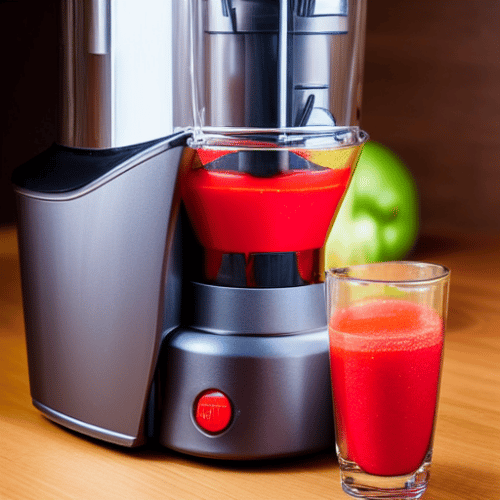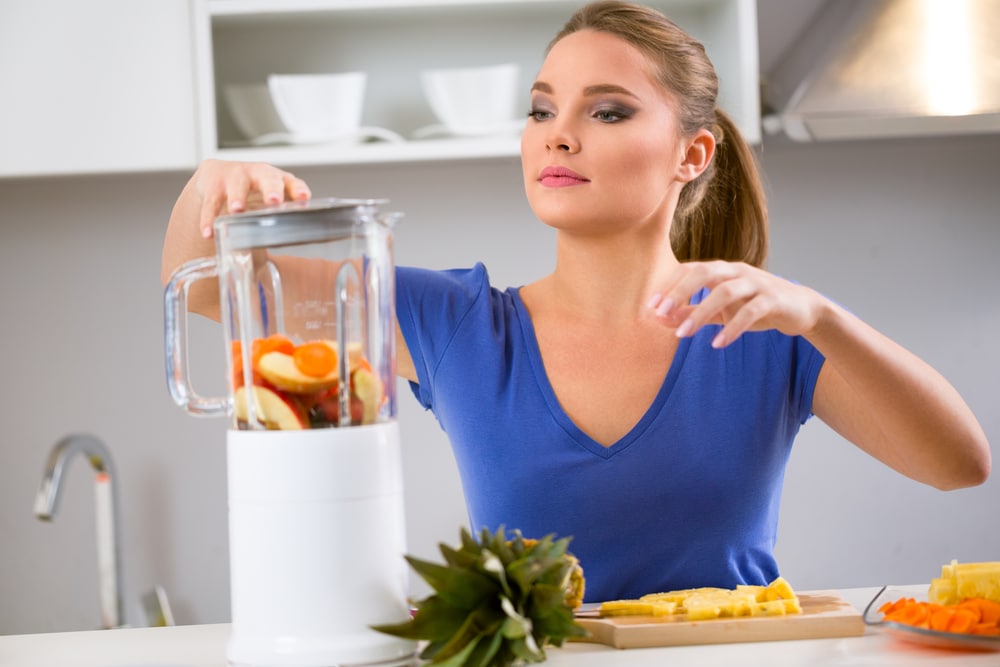Last Updated on
Learning how to use a juicer means you can take full advantage of one of the most valuable tools in your kitchen. As juice recipes with leafy greens and vegetables become more popular, countless people have purchased their equipment to make healthy juice at home.
Making fresh juice is not only enjoyable but there are also a variety of green juice and antioxidant-rich recipes available to improve your health. So whether you’re a lover of fruit juice like apple juice and citrus juice, or you want to experiment with whole fruits and vegetables, you’ve come to the right place.
This article will show you how to use your juicer to accomplish your health and diet goals.
Before You Begin: Knowing Your Juicer
The first step in learning how to master your juice extractor is to know the model or type of juicer you have. Most juicers come in various designs, from the masticating juicer or cold press juicer, which is excellent for nutrients, to the centrifugal juicer, which is great for speed.
If you’re making a wide variety of juices with fruits and veggies, and you don’t want to use a blender, a standard centrifugal juicer might give you the delicious results you’re looking for fast. Alternatively, a slow press or cold press juicer doesn’t cut through your product as quickly, but it can help you extract more juice and nutrients from your ingredients.
Once you know what kind of juicing machine you’re using, read through the instructions provided with the device. The instructions will give you an insight into what kinds of vegetable juice and fruit juice you can make with citrus fruits and leafy greens. Avoid placing anything in the juicer that the machine doesn’t recommend, as this can lead to damage.
Do You Have to Peel Fruit Before Juicing?

Now you know how your new juicer works, you can start prepping your workstation to start juicing. First, clean the juicer before you start using it. Check whether it’s dishwasher safe and wash it by hand with warm soapy water if you’re not sure. You might also need a cutting board and a sharp knife to prepare your fruit.
If you’re using centrifugal juicers, you can add fruits and vegetables in relatively large chunks. However, for a masticating juicer, it’s best to cut the vegetables and fruits into smaller chunks so they fit well into the feed chute. Cutting your produce will also allow you to remove any unwanted seeds and speed up the juicing process.
Gather all the fruits and vegetables you’re going to be juicing. Depending on your machine, you can add all kinds of ingredients to your drink, including spinach, apples, carrots, kale, lemons, limes, pears, oranges, pineapple, and more. Wash each of your ingredients before you add them to the drink to remove any dirt or pesticides. Also, get rid of any seeds, stems, and large pits wherever you can.
Some fruits and vegetables may need to be peeled and chopped, like carrots, pineapple and kale, so you can avoid clogging up your machine. Follow the recipe for guidance on how to save yourself from disaster and potential machine damage.
Using Your Juicer: Step by Step
Now it’s time to begin creating your fresh juice. Depending on the centrifugal juicers or cold press juicers you’re using, the juicing procedure may vary slightly.
- Set up your space, ensuring there’s plenty of room for the juicer and your fruits or vegetables. You should be able to access the feed juice easily.
- Position the collection container under the exit shoot to collect the finished juice.
- Please make sure any plastic and packaging are removed from the juicer, then plug it into the nearest outlet and switch the unit on. The settings should be outlined in your instructions if you’re still uncertain what button to push after gathering all the ingredients and when you’re ready to go.
- Next, add the ingredients, a small amount at a time to the feeding tube. Try not to add too many fruits and vegetables at once, as this can overwork the motor.
- When you’re done adding your ingredients for juicing, replace the cover or lid, and press the button on your juicer model to begin chopping and squashing the ingredients. The juicer should automatically start working on extracting the juice from the pulp. You may need to remove or clear out the pulp from time to time, especially if you’re creating a large batch.
- Keep a close eye on the collection container to ensure it doesn’t overflow. You might decide to add some extra elements to the feed chute at the end, like bonus fruits or fresh mint.
- When you’re done juicing, please clean up your area, and we recommend washing your juicer as soon as possible to keep it in great condition. Remember to follow the instructions on how to clean your device after juicing and what to do with the pulp.
What Should You Not Put in a Juicer?
Although many juicers can extract juice from various ingredients, from leafy greens to citrus fruits, some produce isn’t suitable for a juicer. For example, if you’re making vegetable juice, you shouldn’t use Broccoli because it can cause significant issues with digestion. Other ingredients to avoid when you learn how to use a juicer include:
• Avocado: These don’t contain a lot of juice, so they’re better for smoothies
• Whole Apples: This lovely fruit can be juiced, but you will need to remove the seeds and stems
• Coconut: Coconut milk can add extra moisture, but coconut flesh isn’t a good idea
• Kale: This leafy green is a good juicing product for some people, but it can be problematic if you have issues with kidney performance
• Pears: Most people can juice pears, but it’s best to avoid this fruit if you’re sensitive to fructose
• Pineapple: This fruit is best eaten whole to maintain its high level of vitamins
• Rhubarb: Avoid juicing rhubarb because it will often create a lot of pulp without much juice to drink
• Bananas: Produce like bananas are great for smoothies, but they’re not the best fruit if you’re creating a juice
• Ice: Sometimes, ice will harm the juicing machine, and it doesn’t add much taste to the juice you produce, so it’s best to go without and add whole cubes when serving
Making the Most Of Your Juicer
You can make juice without a juicer, but the difference in results is night and day. With juicers, you can make juices with the best texture. Also, you can retain most, if not all, of the nutrients.
Ideally, the best ingredients for your juicer will be the fruit and vegetables you love best, as well as the produce with the highest amounts of moisture. To get the best taste from your fresh juice, consider experimenting with different fruit and vegetable options, but make sure you avoid anything with high amounts of sugar and fibre.
Depending on the juicer you buy, you can even use your device for certain cooking requirements, like making sauces for your meal. However, you might want to avoid heating the food before you juice it, as this could harm the machine’s internal parts. Cold and room-temperature products are often best for your juicer. Once you’ve learned which juices you like best and which have the most benefits, you can start to make batches of juice.
Crucially, it’s best to avoid filling your fridge with juice when you start using a juicer for the first time, just if you don’t use all of it. Additionally, centrifugal juicers generally produce juices that don’t last as long. If you want to create juice you can save later, try using a juicer described as a “cold press”.
Remember, you can also add more vitamins and nutrients to your juices in the form of powders, but you may want to mix these in after the juicing process is done. This will stop your juicer from removing powders and substances you want in your juice from the mix.
Using Your Juicer
Now that you know how to use a juicer, there’s nothing to stop you from experimenting with a wide selection of different recipes and flavours. Remember, always check the instructions for juicing before you begin using your new machine to avoid any unnecessary damage or accidents, and think carefully about the foods you’re juicing.
Sometimes, taking the time to peel or cut up the products you’re going to be juicing, like apples and carrots, will prevent damage and deliver a better flavour too. Wash your juicing machine thoroughly after each use, and have fun enjoying your freshly-made juice.
What juicer do you have? And do you have any favourite recipes? We’d love to hear about them! So let us know in the comments below.
Rebekah is a writer who loves to explore new products and find hacks that make life easier. She has a knack for all things home improvement, health and fitness. So you’ll often find her on Pinterest or browsing Houzz for ideas.
She’s always looking for the next thing to fix up around the house or what gadget might be just right for her lifestyle. Rebekah enjoys exploring new recipes, taking care of her family, and making sure she stays healthy with regular workouts at the gym.



